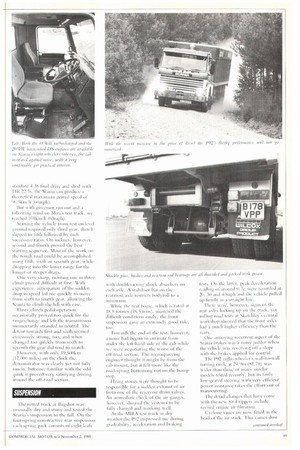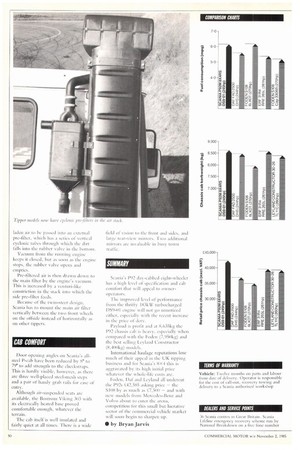T I,„ LATEST 311-ton tipper chassis from Scania offers a much
Page 50

Page 51

Page 52

If you've noticed an error in this article please click here to report it so we can fix it.
broader choice of power and driveline and is :I better pertOrmer than the previous model.
So the competition should not allow themselves to be complacent at the fact that Sunlit has only tour per cent of Britain's eight-wheeler market. Last year Leyland and Volvo betw..eeii them accounted for more than hall of the 1,835 new registrations in this lucrative sector of the market. Hut competition is sharpening up.
Whereas the earlier P82 8X4 used the now discontinued I)Si8-01 chargecooled 7.8-litre engine, the current P92 model which replaced it last year has the benefit of Seania's most fuel-ellicient engine yet, the 8.5-litre )S series.
Two versions are available: the turbocharged D59, which has a maximum net installed power rating of 1801(1X1 (2454), ;111(1 the DSC9 202kW (275h p) unit th;it has the benefit of airto-air charge-cooling.
While the higher-powered 8.5-litre engine excelled at 38 tonnes recently (C.I/ Sep 28, 1985) it is the I83kW version which provides the basis for this week's roadtest report.
Our test vehicle, fitted with a Wilcox 30.6m3 (40yd1) aluminium body and Edbro tipping gear, weighed in at 10.98 tonnes (10 tons 16 cwt) which included a full tank, load sheet and 811kg (1761b) driver.
With its 19.5-tonne (19-ton 4cwt) payload of aggregate, the P92 met exactly the 30.48-tonne legal limit for rigids.
Although the 1)89-0 I does not have quite as good a minimum specific Mel consumption figure as its inter-cooled brother, 200g/k Will at 1,60Orpm is a fair indication of its capabilities.
With nearly 950 of its 977N in of torque available at the same engine Teed, the non-charge-cooled engine is not only a gutsy performer but is ;miong the top models at its weight for economy, too,
Over our demanding 200km (124mile) tipper route, which includes Aroad, dual-carriageways and 56km (35 miles) of tough site conditions, the Scania gave a good account of itself. It returned 46.08 lit/100km (6.13mpg) at
All overall average speed of 39.87km/h (24.08mpli).
This is sonic way behind the 6.32mpg at 23.80mph established six years ago by Volvo's I67kW (2244) F7 but is on a par for Mel economy with the most recent loden 5108 tested. Fitted with the 201kW (27(lhp) Gardner 61..XI)1', the S108 had figures of 6.14mpg and at a much quicker average speed Of 25.16mph.
Our tipper route does not include any motorway work but I drove this tipper along the MI, M25 and M3 from the Motor Industry Research Association test track at Nuneaton to our tipper route at Hag,shot.
Over those 115 miles while fully laden it returned 7.22mpg at a high average speed of 52.5mpli. This gives a good indication of what an operator can expect from the 1'92 with prolonged running at the 60mph legal limit.
But tippers are designed and built to cope with tough off-road conditions and this the Scania 8x4, like Dars FA1)25(I0 eight-wheeler, is no featherweight. In chassis cab form it weighs 8.62 tonnes (8tons lOcwt) leaving about 21.5 tonnes (Mons 3cwt) for the body and payload. This is reduced by 35kg by specifying the GI2871 range-change gearbox instead of the standard GS771 splitter box.
DRIVEL INE
Matching the optional direct-top GI2871 with its much deeper ratios at the lower end of the gears to the
standard 4.38 final drive and shod with 1112 22.5s. the Scania can produce a theoretical maximum geared speed of 96_5kinib ((i14nph).
But with governor 1-1111 out and a Following wind on Mini's test track, we reached 101kmih (63mph).
Starting the vehicle from rest on level ground required only diird gear, then I slipped to fifth followed by each successive ratio. On inclines, however, second and fourth proved die best starting SCTIC11(T. Most of the work on the rough road could he accomplished using fifth, sixth or seventh gear, while dropping into the lower range for the longer or steeper drags.
One very sharp, twisting one in three climb proved difficult at first. With experience, anticipation of the sudden drop in speed led me quickly to move from sixth to fourth gear, allowing the Scania to climb the hill with ease.
Hasty clutch pedal operation occasionally proved too quick for the range-change and left the transmission momentarily stranded in neutral. The detent towards first and sixth seemed excessively strong, too, and when changed too quickly from sixth to seventh the gear did rend to snatch.
However, with only 19,5011km (12,011(f miles) on the clock the demonstrator was clearly et not fully run in. but once familiar with the odd quirk it proved very satisfying driving around the off-road section,
SUSPENSION
The rutted track at Bagshot was unusually dry and stony and tested the Scania's suspension to the full, On the four-spring non-reactive rear suspension each spring pack consists of eight leafs with double-acting shock absorbers on each axle. A stabiliser bar on the rearmost axle restricts bodyroll to a minimum.
While die rear bogie, which is rated at 18.8 tonnes (18.5 tons), mastered the difficult conditions easily, the front suspension gave ;in extremely good ride, too.
Towards the end of tin' test, however, a noise had begun to emanate from under the left-hand side of die cab while We were negotiating the worst of the off-road section. The accompanying engineer thought it might he from the cab mount. but it felt more like the road-spring bottoming out on the bump stop.
Flying stones were thought to be responsible for a sudden exhaust of air from on e of the reservoir drain valves. An immediate check of the air gauges, however, showed the systems to he hill v charged and working well.
At die NI IRA test track in dry weather the I")2 inaprc..ssed me during gradcahility, acceleration and braking tests. 1,)n the latter, peak decellerarion reading ol'around 11.7g were recorded at 20, 311 and 40mph and the vehicle pulled up firmly in a straight line. '[here were, however, signs of the rear axles locking up on the track, yet rolling road tests Jr Sketchley's central workshop showed that the front axles had a much higher efficiency than the rears.
One annoying recurrent aspect of the Scania brakes was a noisy judder when the vehicle was reversing ofa slope with the brakes applied for control.
The P92 eight-,wheeler's wall-to-wall turning circle at 24.9m (81.7ft) was wider than those of manysimilar models tested recently, hut its Fairly low-geared steering with very efficient power assistance takes the ettort out of manoeuvring.
The detail changes that have come with the new 8x4 tippers include revised engine air Filtration.
t:yclone vanes are now fitted in the head o' the air stack. This causes dust
laden air to be passed into an external pre-filter, which has a series of vertical cyclonic tubes through which the dirt falls into the rubber valve in the bottom.
Vacuum from the running engine keeps it closed, but as soon as the engine stops, the rubber valve opens and empties.
Pre-filtered air is then drawn down to the main filter by the engine's VaCUL1111. This is increased by a venturi-like constriction in the stack into which the side pre-filter feeds.
Because of the twill-steer design, Scania has to mount the main air filter vertically between the two front wheels on the offside instead of horizontally as on other tippers.
CAB COMFORT
Door opening angles on Scania's allsteel P-cab have been reduced by 8° to 79° to add strength to the checkstraps. This is hardly visible, however, as there are three well-placed steel-mesh steps and a pair of handy grab rails for ease of entry.
Although air-suspended seats are available, the Bostrom Viking 303 with its electrically heated base proved comfortable enough, whatever the terrain.
The cab itself is well insulated and fairly quiet at all times. There is a wide
field of vision to the front and sides, and large rear-view mirrors. Two additional mirrors are invaluable in busy town traffic.
SUMMARY Scania's P92 day-cabbed eight-wheeler has a high level of specification and cab comfort that will appeal to owneroperators.
The improved level of performanix from the thrifty 183kW turbocharged DS9-ul engine will not go unnoticed either, especially with the recent increase in the price ofderv.
Payload is profit and at 8,635kg the P92 chassis cab is heavy, especially when compared with the Foden (7,95( 1kg) and the best selling Leyland Constructor (8,40(1kg) models.
International haulage reputations lose much of their appeal in the UK tipping business and for Scania's SX4 this is aggravated by its high initial price whatever the whole-life costs are.
Foden, Daf and Leyland all undercut the P92s 1:42,585 asking price the SI08 by as much as 1:7,500 and with new models from Mercedes-Benz and Volvo about to enter the iln.:11d, eolnpetitiomi for this small but lucrative sector of the commercial vehicle market will soon begin to sharpen up.
• by Bryan Jarvis
TERMS OF WARRANTY
Vehicle: Twelve months on parts and labour from date of delivery. Operator is responsible for the cost of call-out, recovery towing and delivery to a Scania authorised workshop
DEALERS AND SERVICE POWS
.16 Scania centres in GreatBritain, Scania Lifeline emergency recovery scheme run by National Breakdown on a free lone number












































































































